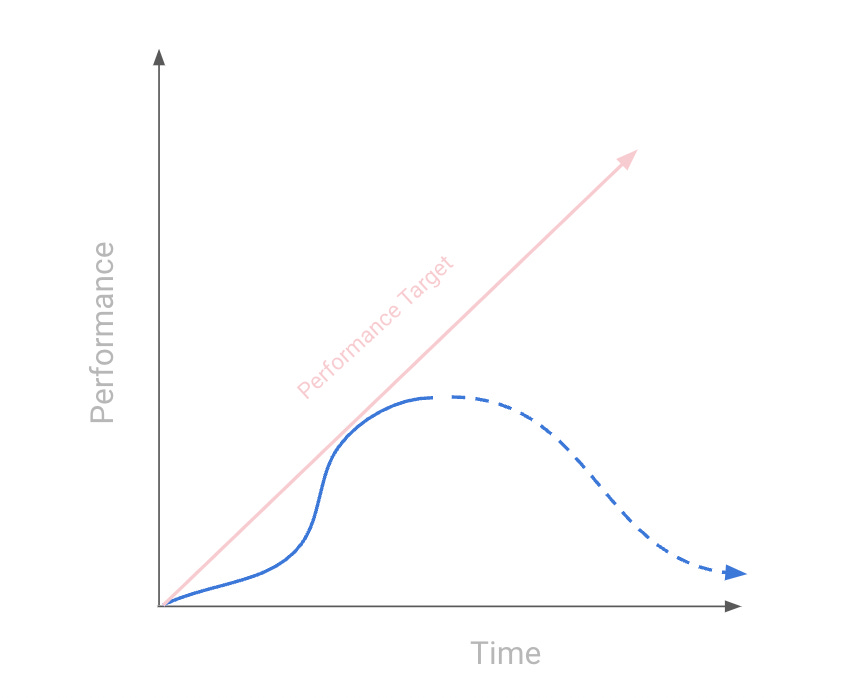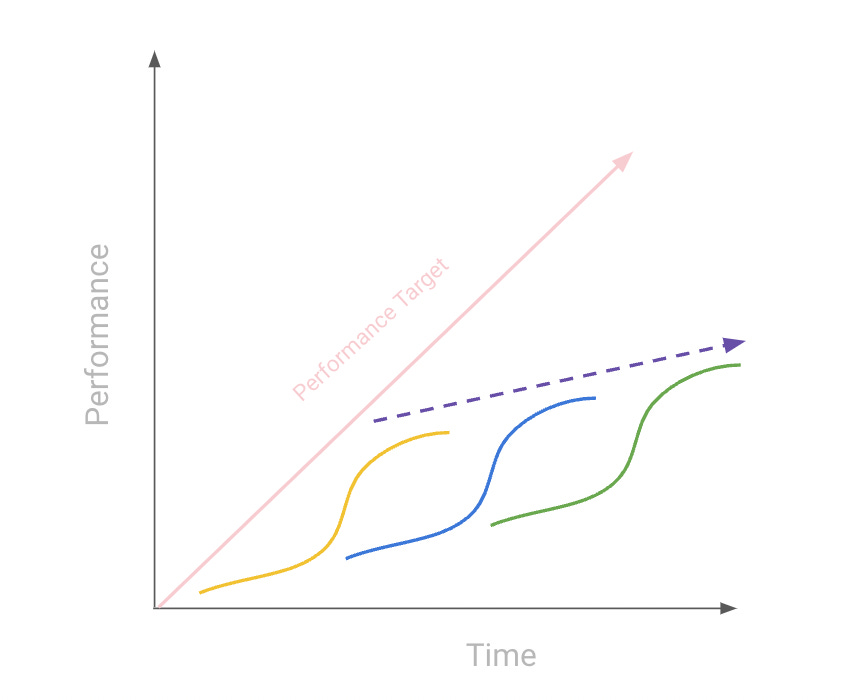Creating a culture of big-bets: The Key to Sustained Growth
How to think about your startup in terms of S-Curves
Introduction
Every company aims to achieve sustained, high growth over time. But in a competitive and rapidly evolving market, growth is rarely a straight line. Instead, it follows a predictable pattern known as the S-curve, a natural trajectory observed in the lifecycle of products, services, and even entire markets.
Each S-curve represents a period of innovation that starts slow, picks up momentum, and eventually slows down as the product matures. To avoid stagnation, companies must strategically launch new products or services to stack S-curves, ensuring growth continues seamlessly. This approach requires a culture that values and supports “big bets” on bold ideas.
1. The Arrow of Ambition
This illustration depicts what I like to call the “arrow of ambition”. This is what every company dreams about when they think of their performance over time: an arrow that is always going upwards and to the right. This target represents the ideal trajectory of consistent growth that many companies aim for but rarely achieve in practice.
2. Performance is Never Really a Straight Line
In reality, growth follows an S-curve with phases of acceleration and deceleration. This illustration shows how real performance moves in waves, contrasting with the straight performance target line. The S-curve model describes three phases:
Early Stage: Slow growth as the idea or product gains traction.
Growth Stage: Rapid acceleration as market adoption peaks.
Maturity and Plateau: Slowed growth as the market becomes saturated.
To achieve that straight-line growth over time, successful companies stack S-Curves on top of each other.
3. Zooming In: Stacking S-Curves
Now let’s zoom into the red box I highlighted in the previous section to examine how two S-Curves tack on top of each other. Anticipating when a current product will begin to decelerate and planning the launch of a new product to overlap with that phase is critical.
As one product reaches the later stages of the S-curve, the goal is to introduce a new product that is well positioned to begin its own growth stage. This way, the growth phase of the new S-curve kicks in just as the older product’s growth begins to slow.
Example: Apple’s strategy of launching new products like the iPhone, iPad, and Apple Watch illustrates this concept. Each device follows its own S-curve, and as one product reaches maturity, Apple launches another, creating a stacked growth model.
4. The Importance of Big Bets
Successfully stacking S-curves requires a company culture that encourages big bets on ambitious, high-stakes ideas. A culture of big bets goes beyond merely fostering creativity—it’s about taking calculated risks on high-potential innovations that could drive future growth. Here’s why this mindset is vital:
Encourages Long-Term Thinking: Big bets often take years to fully mature, requiring companies to start early on the next big thing, even before the current product peaks.
Reduces Stagnation Risk: A single S-curve approach can be dangerous if the market shifts or competitors innovate faster. Diversifying through big bets ensures resilience.
Promotes Agility and Adaptability: With big bets, a company can respond better to market shifts, ensuring continuity even if one product line underperforms.
5. What Happens If You Don’t Launch New Big Bets
Without launching new big bets, performance eventually plateaus, and will almost definitely lead to a decline. Many people assume you can stay indefinitely in a state of plateau, but this is a naive idea that doesn’t take in consideration evolving competitive forces and technology advances. Companies that cling too long to one product or service may struggle to recover as market dynamics shift, and competitors introduce newer, more appealing options.
6. The Pitfalls of Moving On Too Quickly
This illustration captures the opposite risk: moving on to a new big bet before the current one has matured. The result is a series of incomplete S-curves, where neither project reaches its full potential. To avoid this, companies must find the right balance, allowing enough time for each product to peak while preparing the next big idea.
7. Creating an Ecosystem for Sustainable Growth
A culture of big bets is not about betting everything on a single risky project but about building an innovation ecosystem where multiple ideas are explored, nurtured, and scaled. Diversifying across projects provides flexibility and resilience. Key strategies to support this include:
Cross-Functional Collaboration: Diverse teams generate more breakthrough ideas.
Rewarding Smart Risks: Recognize and reward bold thinking, even if not all ideas succeed.
Building a Flexible Innovation Pipeline: Keep several projects in the pipeline, enabling the company to pivot quickly.
Conclusion
Creating a culture of big bets is about more than just innovation—it’s a strategic approach to growth that anticipates the inevitable peaks and plateaus of the market. By stacking S-curves through big bets, companies can sustain momentum and agility, continuously adapting to stay competitive. The result is an organization ready to embrace change and prepared to grow, no matter how markets evolve.
Key Takeaways
Growth follows an S-curve, and companies need to launch new products as others mature.
Stacking S-curves enables smooth transitions and sustained growth.
A culture of big bets fosters risk-taking, long-term planning, and adaptability.
Understanding where a product is on the S-curve guides optimal timing for new initiatives.
Building a diverse ecosystem of big bets ensures resilience and readiness for continuous growth.
In the end, cultivating a big-bet culture means choosing the right opportunities with the right timing and fostering an environment that values innovation and resilience. A company that embraces big bets can transform ambition into sustained success.





